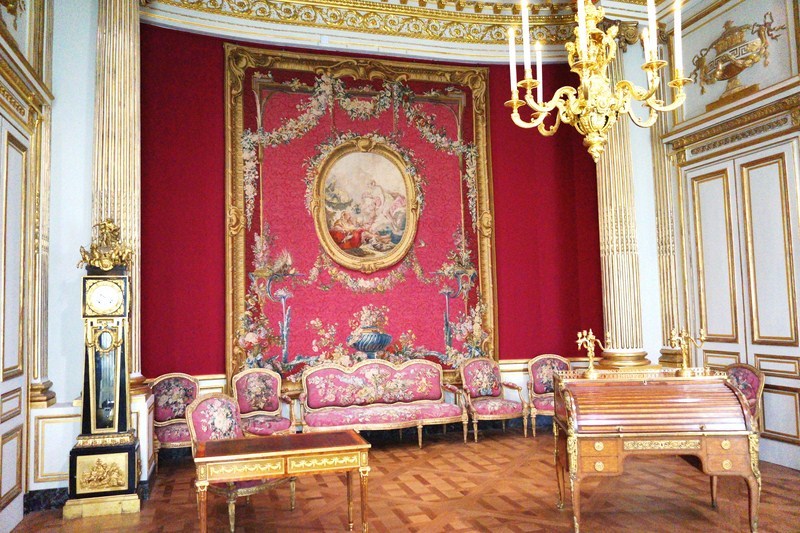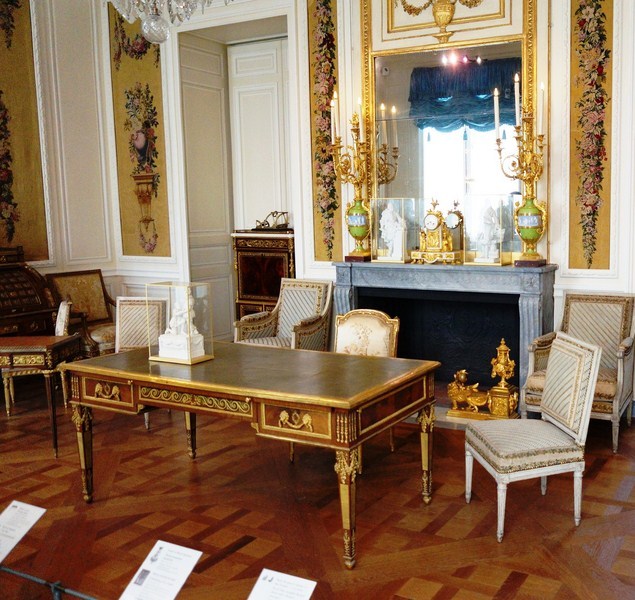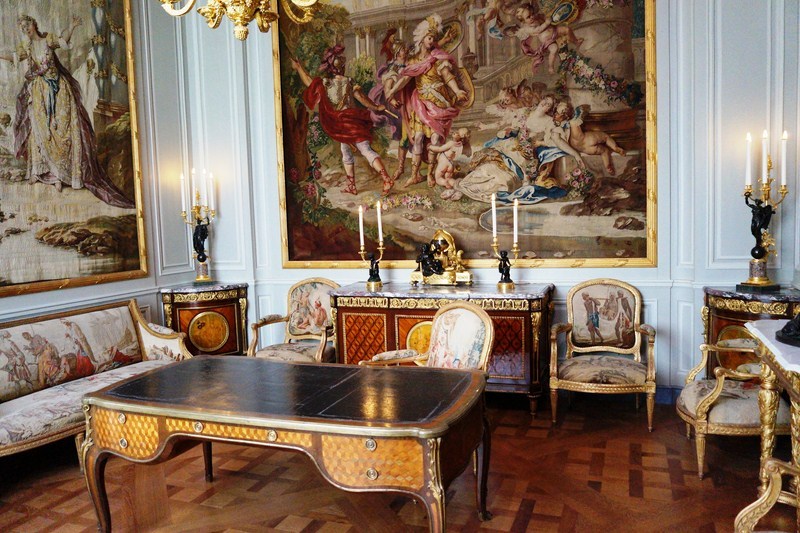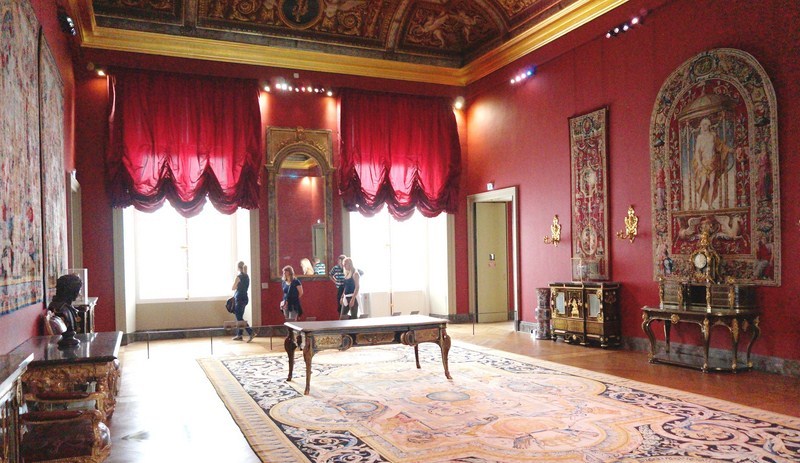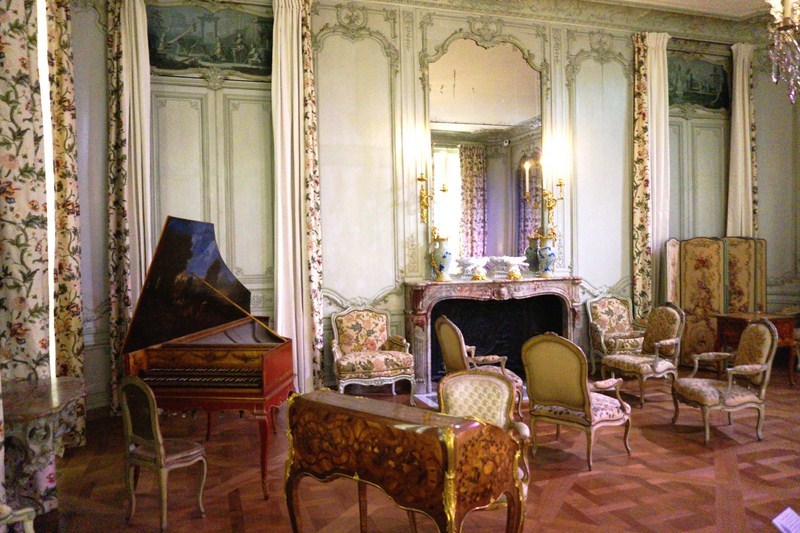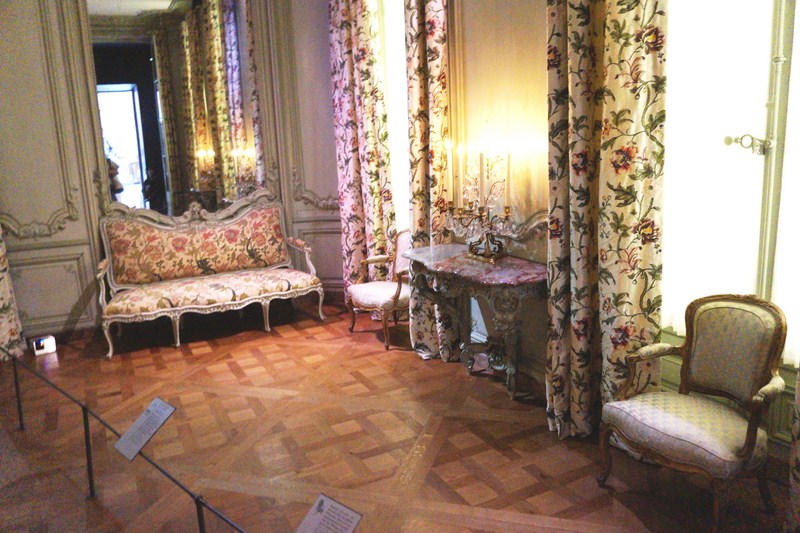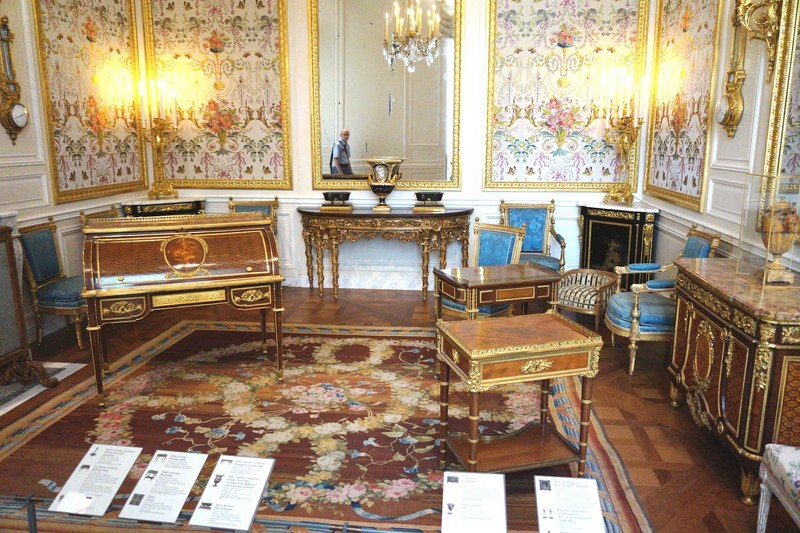The Louvre Museum houses one of the most prized collections of largely 18th-century French decorative arts, some drawn from donations from benefactors like Comte Isaac de Camondo, Baronne Salomon James de Rothschild, Basile de Schlichting, René Grog and Marie-Louise Grog-Carven, J. Paul Getty, the Duchess of Windsor and the Kraemer family.
Check out “Louvre Museum”

Room 601 (Louis XIV Room) with a portrait of King Louis XIV by Hyacinthe Rigaud (oil on canvas, 1701, 277 cm. × 194 cm.)
A section entitled “From Louis XIV to Louis XVI” (“De Louis XIV à Louis XVI”), presented by the Department of Decorative Arts’ Collections, is a series of rooms, with over two thousand treasures of French art and design, we can walk through.

Room 603 with ceiling fresco “La France victorious at Bouvines” (Merry Joseph Blondel) which commemorate the victory at the Battle of Bouvines
This relatively new (opened last June 17, 2014) setting, designed to shed light on both the technical and stylistic history by introducing the major residences and key figures of the time (artists, craftsmen, and those who commissioned their work), offered a broad panorama of interior design, production from major manufactories, crafts, and the art trade.
Primarily French in character, from the reign of Louis XIV up to the French Revolution, this remarkable collection, most originally commissioned for royal or princely residences and formerly the preserve mainly of royalty but now for the enrichment of future generations, consist of wood paneling made of hand carved gilt boiserie and painted decorative elements, lots of gorgeous Sèvres porcelain, some furniture and personal effects of Marie Antoinette‘s, tapestries, fine furniture, decorative bronze work, marble items, gold- and silverware, jewelry, scientific instruments, silks, clocks, European faience, porcelain and sumptuous brocades, all previously hidden away in museum storerooms.
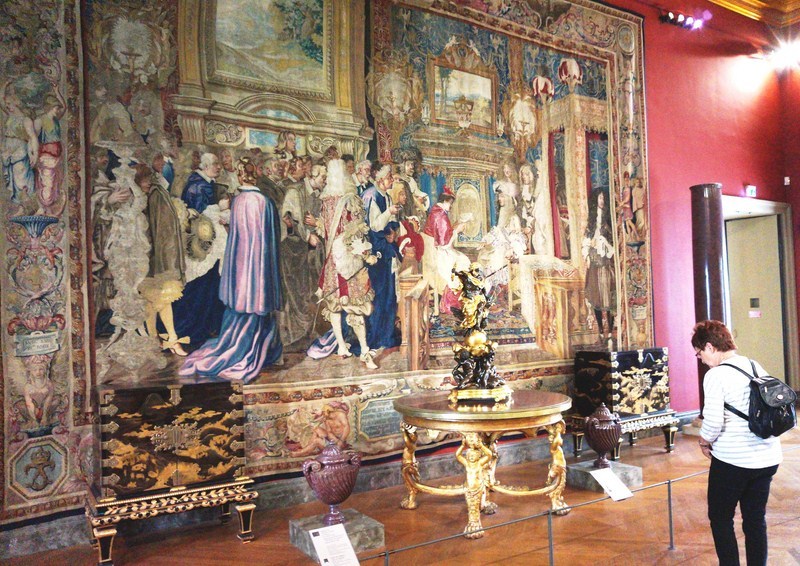
“The Audience given by Loius XIV at Fontainebleau, to Monsignor Cardinal Chigi,” a tapestry at Room 601, made at the Gobelins (Mobilier National, Paris, first version, 1665-1672).
To provide a clearer understanding of this luxurious art of living, particular care had been taken in refurbishing the 33 dedicated galleries which were previously closed for almost a decade. Their approach to exhibition design (masterminded by interior designer and French decorative arts connoisseur Jacques Garcia), adopted by some history museums in the nineteenth century, was to reconstruct the finest inventions of interior decorators and master craftsmen in their natural setting.
Through a US$35.4 million (€26 million) major renovation (the museum’s first major project entirely funded by private donors, mainly by the famous watch manufacturer Breguet) and complete revamp of the Louvre’s Louis XIV, Louis XV and Louis XVI rooms, these masterpieces by the artists and craftsmen from that bygone era were presented in 2,200 sq. m. of exhibition space in chambers that once housed the Council of State and the entire first floor of the north wing of the Cour Carrée.
The visitor trail is divided into three main chronological and stylistic sequences make up – Louis XIV’s personal reign and the Régence (1660–1725), development of the Rococo style (1725–1755) and return to Classicism and the reign of Louis XVI (1755–1790).
A team of artisans, under the supervision of the Louvre’s successive curators of the Department of Decorative Arts under the direction of Marc Bascou, helped the 18th century galleries regain their original splendor, thereby succeeding in safeguarding uncommon skills – cabinetmaking (Charles Cressent, Jean-Jean Henri Riesener, Jean-Baptiste-Claude Séné and Bernard II van Risenburgh), bronze work, silver- and gold smithing (Thomas Germain, Jacques Roëttiers and Robert-Joseph Auguste), gilding, upholstering, painting and decorating (Charles Le Brun and Charles-Antoine Coypel), parquet work and art restoration.
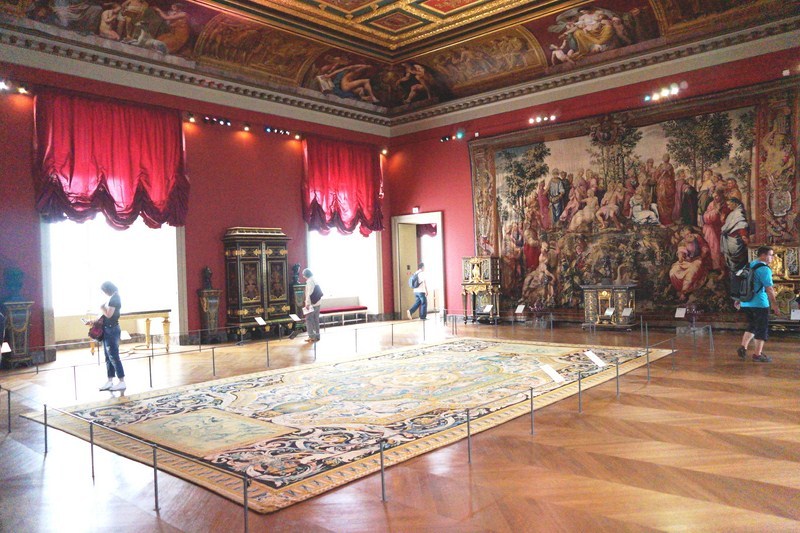
Room 603. On the right is a tapestry set of The Vatican Stanze – Parnassus. A transposition, into tapestry, of one of Raphael’s compositions, painted to adorn a wall in the Stanza della Segnatura (Room of the Signatura) at the Vatican: the god Apollo is depicted as guardian of the arts, surrounded by the Muses and the most illustrious poets.
The rooms, adopting a chronological approach, took us through a natural progression of the major stylistic periods, from the flamboyant Louis XIV aesthetic and the Regency style, to the elaborate but lighthearted Rococo art, followed by a return to the antique taste and Neo-Classicism with its pure, geometrical proportions, straight lines and refined colors.
The master works on display, contributing to the spread of French culture, were done by the greatest artisans of their day, whose workshops served not only the French court, but also its European counterparts.
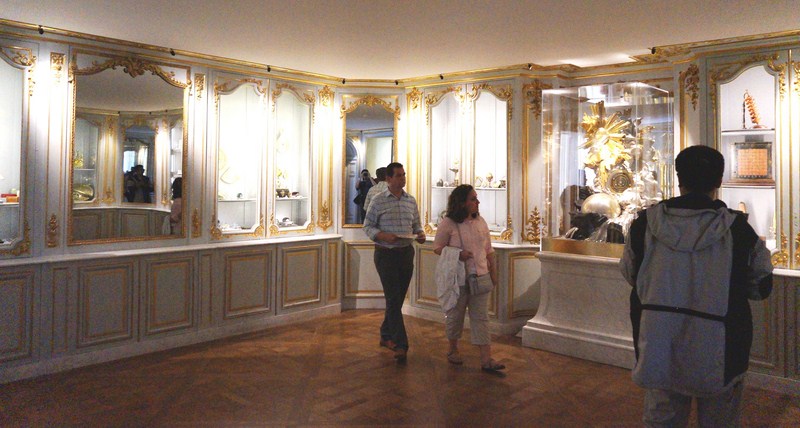
Room 609 displays a collection of scientific instruments (compass, magnets, perpetual calendar, etc.) donated by Nicolas and Simone Landau (1957 and 2002)
The three sparkly “new” and lavish period rooms (a rarity in French museums), formerly from palatial and fashionable private residences of the period and reconstructed, are the. faithfully reconstructed 1750 drawing room, salons, library and private sitting room of the former L’Hôtel Dangé-Villemaré (built in 1709 and redecorated in 1750, it is one of the most important surviving examples of an interior by a Louis XV-era Parisian workshop) at Place Vendôme, the drawing room of the Château d’Abondant, and the ceremonial bedchamber of the Hôtel de Chevreuse). They are in the style of Louis XIV and continue through to Louis XVI and Marie Antoinette.

France, in the Midst of the Legislator, Kings and French Jurisconsults, Receives the Constitutional Charter from Louis XVIII (Merry Joseph Blondel, 1827)
All are prime examples of interior design by Parisian workshops under the reign of Louis XV. Brought back to life and put on display, it reconstituted a coherent decorative setting in terms of floors, paneling, doors, windows, cornices and ceilings, thus allowing us to view objects in historic context.
A fully restored, reassembled and installed cupola fresco, in a Neo-Classical space at the heart of the new galleries, depicts mythological subjects from The Toilet of Venus painted in 1774 by Antoine-François Callet and Pierre-Hyacinthe Deleuze for Louis Joseph de Bourbon, Prince de Condé.
Some of the exceptional pieces in the exhibit include:
- A top-quality, perfectly-proportioned Louis XVI garden with dolphins vase with a blue background in Sèvres porcelain made for the son of the king, painted by Pierre Joseph Rosset l’Ainé and gilded by Jean-Pierre Boulanger.
- A gold coffer made for Louis XIV by goldsmith Jacob Blanck, with a wooden body covered in blue silk satin, cast, chased and filigreed gold and gilt bronze.
- A Marie-Antoinette’s traveling case in mahogany containing 94 objects in silver, crystal, porcelain, steel, ivory and ebony.
- An amazingly-detailed carved, elegantly painted and gilded wood paneling, originally created for aristocrat Le Bas de Montargis’ residence, which once adorning the Comte d’Artois’ Turkish-designed study in Versailles
- A complete set of nine decorative paintings, in the grotesque style, depicting leisurely country pastimes by Jean-Baptiste Oudry.
- A Louis XVI commode, by Martin Carlin, with a red griotte marble top, ebony and rosewood veneers and chased gilt-bronze mounts which highlights imported Japanese lacquer screen panels featuring Asian landscapes (among the best examples in the world of the cultural exchanges between Asia and France at the time).
- A set of six straight-backed armchairs and a sofa owned by the financier Pierre Crozat in carved, gilded walnut, red and fawn-colored leather, and red-and-white silk braiding
- A roll-top desk by Jean-François Leleu in oak, tulipwood veneer, gilt bronze and marquetry of barberry wood, hollywood, maple burr and boxwood on brown-stained maple, decorated with Sèvres porcelain plaques.
- An armoire, for the royal furniture depository, in oak, softwood, ebony veneer, marquetry of tortoise shell, brass, pewter and stained horn, and gilt-bronze mounts, created by André-Charles Boulle, the first cabinetmaker to use lavish gilt-bronze mounts to enhance the decoration of his furniture.
The luxurious art of living was made instantly perceptible and easier to understand via this museological concept, returning the creations of decorators and master artisans to their natural environment.
From Louis XIV to Louis XVI: First Floor, Sully Wing, Louvre, 75001 Paris, France. Tel: +33 1 40 20 50 50. Open daily, except Tuesdays and holidays, 9 AM- 6 PM (until 10 PM on Wednesday and Friday evenings).
The Louvre has three entrances: the main entrance at the pyramid, an entrance from the Carrousel du Louvre underground shopping mall, and an entrance at the Porte des Lions (near the western end of the Denon wing).
Admission is free, from October to March, on the first Sunday of every month. Still and video photography is permitted for private, noncommercial use only in the galleries housing the permanent collection. The use of flash or other means of artificial lighting is prohibited. Photography and filming are not permitted in the temporary exhibition galleries.
How To Get There: the Louvre can be reached via Metro lines 1 and 7, station Palais Royal – Musée du Louvre Métro or the Louvre-Rivoli stations. By bus, take No. 21, 24, 27, 39, 48, 68, 69, 72, 81, 95 as well as the touristic Paris l’Open Tour. By car, there is an underground parking reachable by Avenue du Général Lemonier, every day from 7 AM – 11 PM.

